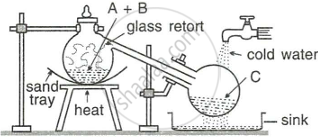Advertisements
Advertisements
प्रश्न
The figure given below illustrates the apparatus used in the laboratory preparation of nitric acid.

- Name A (a liquid), B (a solid), and C (a liquid). (Do not give the formulae).
- Write an equation to show how nitric acid undergoes decomposition.
- Write the equation for the reaction in which copper is oxidised by concentrated nitric acid.
उत्तर
- A: Conc. sulphuric acid
B: Sodium nitrate or Potassium nitrate
C: Nitric acid - \[\ce{4HNO3 ->[Heat][Sunlight] 4NO2 + 2H2O + O2}\]
- \[\ce{Cu + 4HNO3 -> Cu(NO3)2 + 2NO2 + 2H2O}\]
APPEARS IN
संबंधित प्रश्न
Explain with the help of a balanced equation, the brown ring test for nitric acid.
Can we use conc. HCl in place of Conc. H2SO4 ?
What happens when (Given balanced equation) :
Sulphar is added to hot and conc. HNO3?
Complete and balance the following equation :
C + HNO3 → ___________
Complete and balance the following equation :
FeSO4 + NO + H2O → ______________
Choose the correct answer from the option given below :
Nitric acid on standing develops brownish colour which may be attributed to the presence of :
Give reason for the following:
In the laboratory preparation of nitric acid, the mixture of concentrated sulphuric acid and sodium nitatre should not be heated very strongly, above 200°C
Account for the yellow colour that appears in concentrated nitric acid when it is left standing in an ordinary glass bottle.
Explain why only all-glass apparatus should be used for the preparation of nitric acid by heating concentrated sulphuric acid and potassium nitrate.
What is the property of nitric acid which allows it to react with copper?
